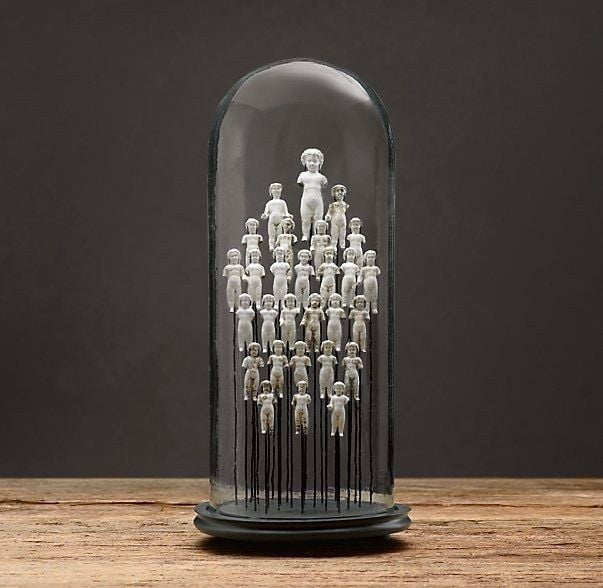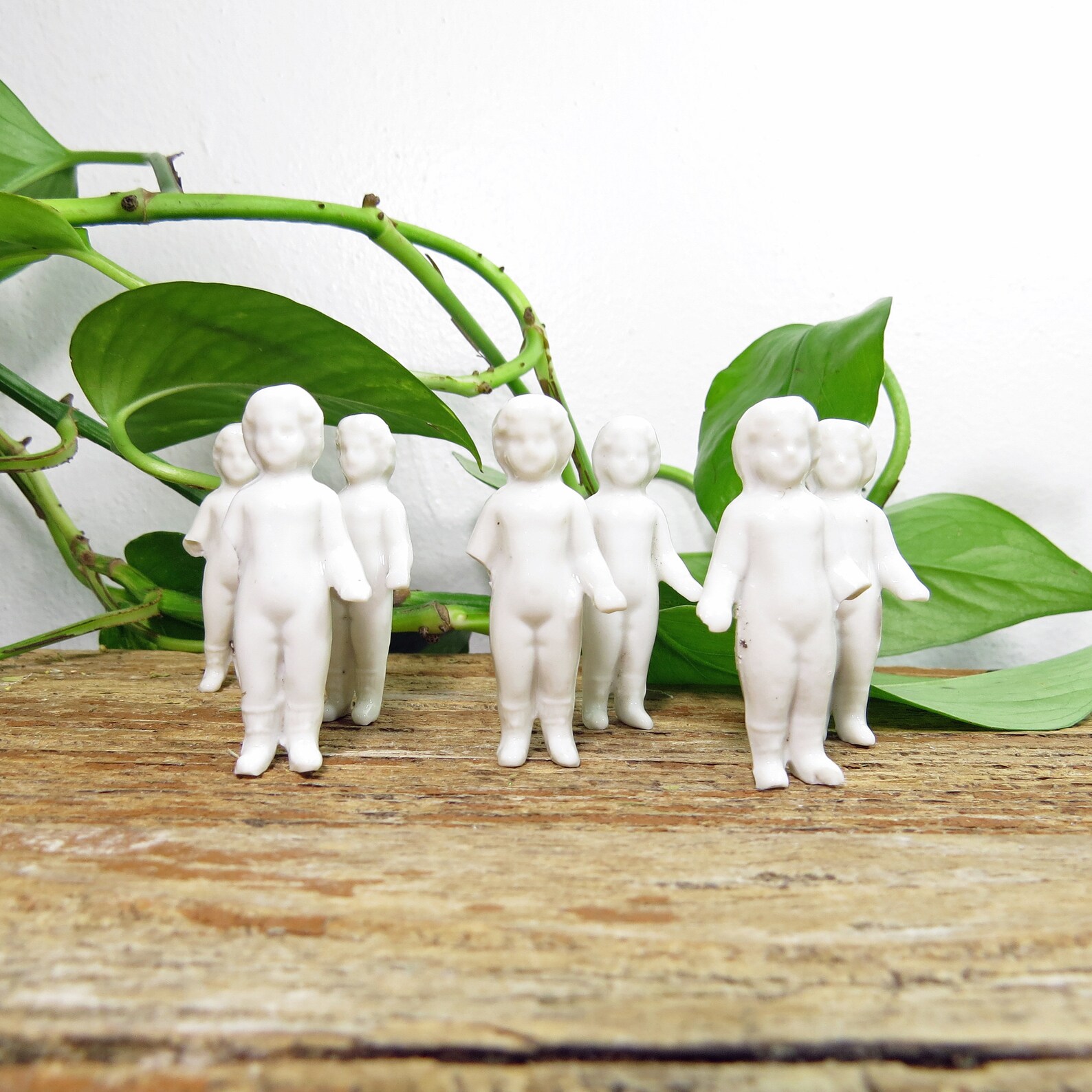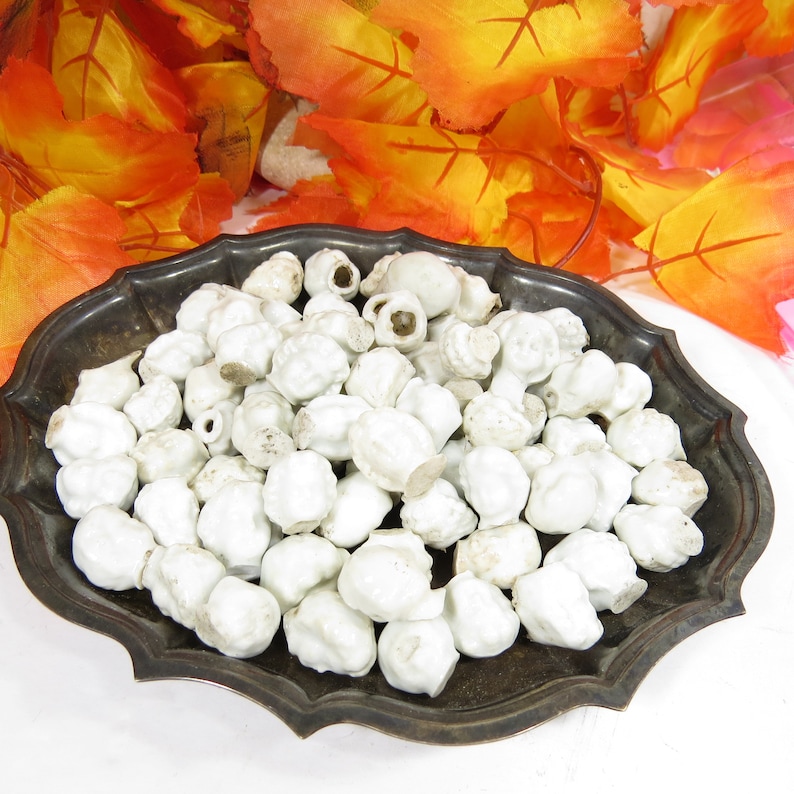Dive into the captivating journey of Frozen Charlotte dolls, uncovering their intriguing past and how these tiny porcelain treasures bring a touch of vintage whimsy to modern decor.
According to my family, I have a penchant for creepy dolls. So the fact that I’m drawn to Frozen Charlotte dolls should come as no surprise, right?
The first time I spied Frozen Charlotte dolls was in a photo from an interior designer whose name I can’t remember! But they were grouped together in a bowl, sitting on a coffee table in a living room. (If you know the photo and designer I’m referring to, please remind me!)

Since first seeing that photo, I became intrigued with these mysterious white porcelain dolls. Not long after, I came across a vendor selling a few at Alameda Point antique fair. Of course, now I’m kicking myself that I didn’t buy them!
One time highly sought after by young girls to play with in the bath or bake into a cake, these antiques are now sought after by collectors today.
So are these creepy corpses or beautiful children’s toys? Well, I’ll let you decide.
What is a Frozen Charlotte
A Frozen Charlotte is a petite porcelain baby, standing anywhere from 1″ to 18″ tall. These dolls are usually made from unglazed porcelain, bisque, or China. They have a matte, ivory-colored finish, which sets them apart from glossy porcelain dolls. They are formed as one solid piece and have no joints, thus giving rise to the name “Frozen”. Some have dark-painted hair and red lips but they are otherwise as white as snow.
These white porcelain dolls were made between c. 1850- c.1920, mostly in Germany and then Britain. These were inexpensive bath toys made to float and affordable enough that kids could buy them with their pocket money. The smallest dolls were often known as Penny dolls because they could be bought with a penny, and were used for play in doll’s houses.
You’ll mostly find female versions of these nightmarish baby dolls, but occasionally, you might see what are known as Frozen Charlies, the male counterpart.
History
When first introduced in Germany, these bisque dolls were intended as bathtime toys. The dolls could float were sometimes sold in tiny bathtubs or even coffins!
Later, during the rise of the Victorian era, these dolls gained popularity in Britain and America. In America, instead of being bath toys, the dolls were baked into desserts, such as the Mardi Gras king cake. Finding the doll in your slice of cake means prosperity for the finder!
During the Victorian era, roughly from the 1850s to the 1890s, Frozen Charlotte dolls reached the pinnacle of their popularity. They were cherished not only as children’s toys but also as novelties and keepsakes. One tradition that contributed to their popularity was the custom of “Queen Cake” during Twelfth Night celebrations. In this tradition, a small porcelain figure, such as a Frozen Charlotte, was baked into a cake. The person who discovered the porcelain figure in their slice of cake would be crowned king or queen of the festivities.
The History of the Name
Once known as pillar dolls, solid chinas or bathing babies, the name Frozen Charlotte came later.
The name “Frozen Charlotte” for these small porcelain dolls has its origins in an American folk ballad, based on the poem “A Corpse Going to a Ball” by Seba Smith. The ballad tells the story of a young woman named Charlotte who was traveling to a New Year’s ball in an open sleigh during winter with her beau Charles. Despite the frigid weather, she refused to cover herself with a blanket, fearing it would hide her beautiful gown. Tragically, Charlotte froze to death during the journey.
The connection between the name and the dolls lies in the fact that, like the unfortunate Charlotte in the song, these dolls are often depicted as being barefoot and without clothing. Some versions of the dolls have a simplistic, nude appearance, which is believed to have inspired the name “Frozen Charlotte.” The ballad itself, titled “Young Charlotte” or “Fair Charlotte,” was widely known and sung in the United States during the 19th century. The popularity of the ballad likely contributed to the adoption of the name for these small porcelain dolls, which began to emerge around the same time. The name “Frozen Charlotte” added an element of charm and intrigue to these dolls, linking them to the tragic tale of a young woman who paid the price for vanity and fashion in a harsh winter’s night.
Was Frozen Charlotte Real
Yes in a roundabout way. A New York Observer article published in February 8, 1840 included a story about a woman in upstate New York who froze to death on her way to a New Year’s ball. That article gave rise to the poem by Seba Smith.
Ultimately, Frozen Charlotte dolls became eerie reminders for children to obey their parents.
Are Frozen Charlotte Dolls Haunted
Well, I’m not a ghost expert that’s for sure, but my guess would be no! If you look at their history, these dolls were thought to bring good luck. Plus, many of the dolls for sale today on sites like eBay and Etsy are not pre-owned dolls, but rather those excavated in Germany.
During the war, many of the doll factories were either abandoned or destroyed, burying the Frozen Charlotte inventory in the dirt. These dolls are now hunted for and dug up by excavators for the many collectors who covet them.
Decorating Ideas for Frozen Charlotte Dolls
Frozen Charlotte dolls offer a realm of creativity for display and decoration. Here are some imaginative ideas to explore:
Holiday Decor and Ornaments
Incorporate Frozen Charlotte dolls into your holiday decor. Adorn your Christmas tree with these miniature treasures or use them in your festive table settings to add a touch of nostalgic charm.
Jewelry and Accessories
Transform Frozen Charlotte dolls into unique pieces of jewelry or accessories. Attach them to necklaces, brooches, or keychains for wearable vintage elegance.
Curio Cabinet Displays
Create captivating displays in a curio cabinet or glass display case, protecting the dolls while providing a charming and visually captivating arrangement.
Victorian-Inspired Vignettes
Design vignettes with a Victorian flair, placing Frozen Charlotte dolls alongside other nostalgic items like vintage books, keys, or shoe forms.
A Bowl of Babies
I know this sounds odd, but you can just group them together in a small dish on the coffee table. Talk about a conversation starter!
How to Determine Their Value
Frozen Charlotte dolls are quite expensive for their size! If you’re buying one or two, or perhaps just a head, the price is achievable. But if you want to create a collection, be prepared to spend $100 at a minimum.
Assessing the value of a Frozen Charlotte doll involves considering various factors:
Condition
The condition of a Frozen Charlotte doll plays a crucial role in determining its value. Collectors prefer dolls that are in excellent condition with minimal damage, such as chips, cracks, or paint loss. Or course, given that they are largely excavated finds, many are just torsos, or heads, or even just limbs.
Age
Antique Frozen Charlotte dolls, particularly those from the mid-19th century, tend to be more valuable. Older dolls carry historical significance and often possess unique characteristics.
Size
Assuming the condition is the same, larger dolls are more expensive to buy than small ones.
Materials and Manufacturing
Dolls made from unglazed porcelain or bisque are typically more valuable than newer reproductions. Additionally, dolls from reputable manufacturers may hold greater value.
Provenance
A documented history of ownership, or provenance, can significantly impact a doll’s value. If the doll has a known history, it may be more desirable to collectors.
Design Rarity
Unusual designs, molds , or themes can increase a doll’s desirability and value. Some collectors seek specific variations or limited edition releases.
Expert Appraisal
For an accurate and professional assessment of a Frozen Charlotte doll’s value, consider consulting with antique doll experts or appraisers who specialize in this niche.
More Antiques
- Decorating with Santos Cage Dolls – Cool or Creepy?
- 25+ Beautiful Ideas for Decorating with a Dough Bowl
- Decorating with French Olive Jars
- The Ultimate Guide to French Bergère Chairs

Join the Community
Let’s keep in touch! Get exclusive artwork plus the latest news delivered directly to your Inbox!




Just love your historical stories. Very intriguing. Next time I go antiquing with my husband, I’m going to look for frozen Charlotte. And because of you, I’m also a collector of Santo’s dolls as well. I get the same feedback from my family ;) I love the unusual, they can be very charming.
I’ve never heard of the dolls. That was very interesting. I don’t think I’ve ever seen one. I love learning about different things. Thank you.